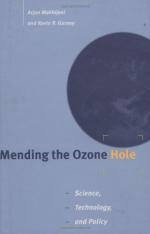|
This section contains 903 words (approx. 4 pages at 300 words per page) |

|
In 1985, atmospheric scientists discovered that stratospheric ozone over Antarctica had been reduced to half its natural level. This local loss, termed the Antarctic ozone hole, was traced to destruction of stratospheric ozone by human-made chemicals, especially chlorofluorocarbons (CFCs; artificial compounds consisting of chlorine, fluorine, and carbon and widely used as refrigerants and aerosol spray propellants). Other evidence indicates that ozone levels potentially declining over other regions, though nowhere as drastically as over Antarctica.
The ozone hole covers an area over the Antarctic continent, the surrounding ocean, the southern tip of South America in which stratospheric ozone begins to diminish every August (at the beginning of the Southern hemisphere's spring season), reaches a minimum of less than 50% of its natural value in October, and returns to normal levels by the beginning of December.
Essential to the formation of the...
|
This section contains 903 words (approx. 4 pages at 300 words per page) |

|


